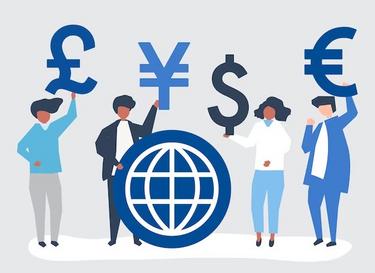What is fiat currency?
Fiat currency[1] is legal tender[2] whose value is backed by the government that issued it. Unlike commodity money, which is backed by a physical good such as gold or silver, the value of fiat money is derived from the relationship between supply and demand rather than the value of the material from which the money is made.
- Characteristics of Fiat Currency
- Advantages and Disadvantages
- Global Use of Fiat Currency
- Fiat Currency vs. Cryptocurrency
- What is fiat currency?
- Definition and Characteristics of Fiat Currency
- History and Evolution of Fiat Money
- Advantages of Fiat Currency
- Challenges and Criticisms of Fiat Currency
- Fiat Currency in the Digital Age
- Comparison with Cryptocurrencies
- The Future of Fiat Currency
Characteristics of Fiat Currency
Fiat currencies have several defining characteristics:
- Government Backed: Fiat money is issued by a government and declared to be legal tender.
- No Intrinsic Value: Unlike commodities, fiat money does not have intrinsic value or use value.
- Supply and Demand: The value of fiat money is determined by market forces of supply and demand.
Advantages and Disadvantages
The use of fiat currency allows governments greater flexibility in economic management, such as adjusting money supplies to manage economic variables. However, it also poses risks such as inflation[3] if the money supply is not carefully managed.
Global Use of Fiat Currency
Most of the world’s currencies, including the US dollar, the Euro, and the Japanese yen, are fiat currencies. The transition to fiat money has been a key factor in the development of the modern global financial system.
Fiat Currency vs. Cryptocurrency
Fiat currency and cryptocurrency represent two different approaches to currency. While fiat currency is centralized and regulated by governments, cryptocurrency offers a decentralized alternative, promising increased efficiency and lower transaction costs.
What is fiat currency?
Fiat currency represents the most widely used form of money in the global economy today, serving as the backbone of financial transactions worldwide. Unlike commodities or asset-backed currencies, where the value is derived from physical goods like gold or silver, fiat money is based entirely on the trust and confidence in the issuing government. It has no intrinsic value; its value comes from the guarantee by a government that it will be accepted as a form of payment within its jurisdiction. This concept is crucial for understanding modern economics, international trade, and the global financial system.
Definition and Characteristics of Fiat Currency
Fiat currency is legal tender whose value is not backed by a physical commodity but by the trust that individuals and governments have in the issuer, typically a country’s government or central bank. The value of fiat money is largely derived from the relationship between supply and demand and the stability of the issuing government, rather than the worth of a physical material.
History and Evolution of Fiat Money
The transition from commodity-based currencies to fiat money marks a significant evolution in the financial world. This section explores the historical shift from coins and notes backed by gold or silver to the modern system of fiat currency, highlighting key moments and decisions that led to the widespread adoption of fiat money.
Advantages of Fiat Currency
Fiat currencies offer several advantages, including greater control over the economy for governments, the ability to respond to economic crises by adjusting money supply, and the elimination of the need to possess physical commodities to back the currency. This flexibility supports economic growth and stability.
Challenges and Criticisms of Fiat Currency
Despite its advantages, fiat currency faces criticism, particularly regarding inflation and devaluation. Since the supply of fiat money can be increased at will by central authorities, there is a risk of oversupply, which can lead to inflation or even hyperinflation. Additionally, fiat money depends heavily on government stability and economic policies, making it vulnerable to political and economic crises.
Fiat Currency in the Digital Age
The digital age has transformed how fiat currencies are used, with digital transactions becoming increasingly prevalent. This section discusses the impact of technology on fiat money, including the rise of digital payments, online banking, and the challenges and opportunities these advancements present for traditional fiat currencies.
Comparison with Cryptocurrencies
With the advent of cryptocurrencies, fiat currencies face a new form of competition. Cryptocurrencies challenge the traditional fiat system with their decentralized nature, offering an alternative approach to money and monetary policy. This section compares and contrasts fiat currencies with cryptocurrencies, discussing their respective advantages, disadvantages, and potential futures.
The Future of Fiat Currency
Looking ahead, the future of fiat currency is subject to ongoing debate and speculation. This section explores potential developments and challenges, including the role of central bank digital currencies[6] (CBDCs), the impact of inflationary pressures, and the ongoing relevance of fiat money in an increasingly digital and decentralized financial landscape.
In conclusion, fiat currency plays a critical role in the global economy, facilitating transactions, and serving as a measure of value and a store of wealth. While it offers significant advantages in terms of flexibility and economic control, it also faces challenges and criticisms, especially in an era of technological advancements and the emergence of alternative currencies. Understanding the complexities of fiat currency is essential for navigating the modern financial system and anticipating future developments in the world of money.
- Fiat Currency — Government-issued currency not backed by a physical commodity, like gold or silver.
- Legal Tender — Money that must be accepted if offered in payment of a debt.
- Inflation — The rate at which the general level of prices for goods and services is rising, and, subsequently, purchasing power is falling.
- Cryptocurrency — Digital or virtual currency secured by cryptography, facilitates secure, anonymous transactions.
- Cryptocurrencies — Digital or virtual currencies that use cryptography for security and operate on a decentralized system, unlike traditional currencies.
- Digital currencies — Digital forms of money that exist only in electronic form, not in physical form like coins or notes.
- Federal Reserve Bank. 'What is Fiat Money?', 2020.
- Investopedia. 'Fiat Money', 2021.



